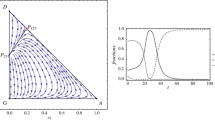Abstract
The iterated prisoners dilemma (IPD) is a simple model for the study of the emergence of cooperative behavior in populations of selfish individuals. In this work, we challenge the assumption that players move in synchrony, and develop a general Markovian model that allows the study of a wide spectrum of scenarios. Simulations show that the relative timing of player moves, and the reward for mutual cooperation, influences the strategy that eventually dominates the final population. For a synchronous environment, reciprocal behavior appears to be the key to the evolution of cooperation, while in an asynchronous environment, guarded generosity may be a route to the evolution of cooperation.
Similar content being viewed by others
References
Axelrod R, Hamilton W (1981) The evolution of cooperation. Science 211(4489):1390–1396
Axelrod R (1984) The evolution of cooperation. Basic Books, New York
Milinski M (1987) Tit-for-tat in sticklebacks and the evolution of cooperation. Nature 325:434–435
Dugatkin LA (1988) Do guppies play tit-for-tat during predator inspection visits? Behav Ecol Sociobiol 23:395–399
Godard R (1993) Tit-for-tat amongst neighbouring hooded warblers. Behav Ecol Sociobiol 33:45–50
Packer C (1977) Reciprocal altruism in Papio anubis. Nature 265: 441–443
Molander P (1985) The optimal level of generosity in a selfish uncertain environment. J Conflict Resolution 29:611–618
Nowak MA, Sigmund K (1990) The evolution of stochastic strategies in the prisoner’s dilemma. Acta Appl Math 20:247–265
Cornforth D, Green DG, Newth D (2005) Ordered asynchronous processes in natural and artificial systems. Physica D 204:70–82
Nowak M, Sigmund K (1992) The alternating prisoner’s dilemma. J Theor Biol 168:219–226
Nowak MA, Sigmund K (1993) A strategy of win-stay, lose-shift that outperforms tit-for-tat in prisoner’s dilemma. Nature 364: 56–58
May RM (1987) More evolution of cooperation. Nature 327: 15–17
Maynard-Smith J (1982) Evolution and the theory of games. Cambridge University Press, Cambridge
Nowak MA (2006) Evolutionary dynamics. Harvard University Press, Cambridge
Frean M (1994) The prisoner’s dilemma without synchrony. Proc R Soc Ser B London 257:75–79
Nowak MA, Bonhoeffer S, May RM (1994) Spatial games and the maintenance of cooperation. Proc Nat Acad Sci 91:4877–4881
Huberman BA, Glance NS (1993) Evolutionary games and computer simulations. Proc Natl Acad Sci 90:7716–771
Author information
Authors and Affiliations
Corresponding author
About this article
Cite this article
Newth, D., Cornforth, D. The emergence of cooperation in the random asynchronous prisoner’s dilemma. Artif Life Robotics 12, 329–334 (2008). https://doi.org/10.1007/s10015-007-0487-z
Received:
Accepted:
Published:
Issue Date:
DOI: https://doi.org/10.1007/s10015-007-0487-z




